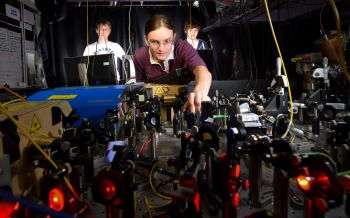16 January 2015
Physicists at the University of Sussex have tamed one of the most counterintuitive phenomena of modern science in their quest to develop a new generation of machines capable of revolutionizing the way we can solve many problems in modern science.
The strange and mysterious nature of quantum mechanics is often illustrated by a thought experiment, known as Schrӧdinger's Cat, in which a cat is theoretically both dead and alive simultaneously.
According to a new study published this week in Physical Review, Sussex physicists have now managed to create a special type of "Schrӧdinger's" cat using new technology based on trapped ions (charged atoms) and microwave radiation.
Like the cat, the researchers made these ions exist in two states simultaneously by creating ‘entanglement’, an effect that challenges the very fabric of reality itself.
Trapped ions are leading the race towards constructing a new type of computer able to solve certain problems with unprecedented speeds by taking its power from a theory called ‘quantum physics’.
Traditionally, lasers have been used to drive such quantum processes. But millions of stable beams would have to be carefully aligned in order to be able to work with the very large number of ions required to encode a useful amount of data.
It would be much easier to build a quantum computer that uses microwave radiation instead of lasers for all quantum operations because, just like in a standard kitchen microwave, the radiation is easily broadcast over a large area using well-developed and inherently stable technology.
The Sussex researchers' ability to create and fully control a Schrӧdinger's cat ion using microwave radiation instead of lasers constitutes a significant step towards the realisation of a large scale microwave quantum computer.
Dr Winfried Hensinger, who leads the Sussex team, says: “While constructing a large scale quantum computer is still a significant challenge, this achievement demonstrates that we are moving beyond basic science towards realizing new step-changing technologies that have the potential to change our lives.”
Dr Hensinger’s team, consisting of postdoctoral fellows Dr Seb Weidt and Dr Simon Webster, along with PhD students Kim Lake, Joe Randall and Eamon Standing, worked for over two years to develop this microwave based technology that is capable of significantly simplifying the engineering required to build an actual quantum computer.
Dr Seb Weidt says: “This achievement opens up a whole range of opportunities to realize new quantum technologies.”
The Sussex Ion Quantum Technology Group is part of the UK Quantum Technology Hub on Networked Quantum Information Technologies and the UK Quantum Technology Hub for Sensors and Metrology bringing together universities and industry to develop and construct new quantum technologies. The group is funded by the UK Engineering and Physical Sciences Research Council, the European Commission and the University of Sussex.
‘Generation of spin-motion entanglement in a trapped ion using long-wavelength radiation ', by K. Lake, S. Weidt, J. Randall, E. D. Standing, S. C. Webster, and W. K. Hensinger, is published in Physical Review A [Phys. Rev. A 91, 012319 (2015)].
http://journals.aps.org/pra/abstract/10.1103/PhysRevA.91.012319















